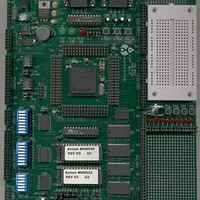MPC555CME Freescale Semiconductor, MPC555CME Datasheet - Page 263

MPC555CME
Manufacturer Part Number
MPC555CME
Description
KIT EVALUATION FOR MPC555
Manufacturer
Freescale Semiconductor
Type
Microcontrollerr
Datasheet
1.MPC555CME.pdf
(966 pages)
Specifications of MPC555CME
Contents
Module Board, Installation Guide, Power Supply, Cable, Software and more
Processor To Be Evaluated
MPC555
Data Bus Width
32 bit
Interface Type
RS-232
For Use With/related Products
MPC555
Lead Free Status / RoHS Status
Contains lead / RoHS non-compliant
- Current page: 263 of 966
- Download datasheet (13Mb)
8.2 System Clock Sources
8.3 System PLL
MPC555
USER’S MANUAL
*
Resistor is not currently required on the board but space should be available for its addition in the future.
The system clock can be provided by the main system oscillator (OSCM), an external
clock input, or the backup clock (BUCLK) on-chip ring oscillator, see
The OSCM uses either a 4-MHz or 20-MHz crystal to generate the PLL reference
clock. When the main system oscillator output is the timing reference to the system
PLL, skew elimination between the XTAL/EXTAL pins and CLKOUT is not guaran-
teed.
The external clock input receives a clock signal from an external source. The clock fre-
quency must be either in the range of 3 MHz – 5 MHz or at the system frequency of at
least 15 MHz (1:1 mode). When the external clock input is the timing reference to the
system PLL skew elimination between the EXTCLK pin and the CLKOUT is less than
±
The backup clock on-chip ring oscillator enables the MCU to function with a less pre-
cise clock. When operating from the backup clock, the MCU is in limp mode. This en-
ables the system to continue minimum functionality until the system is fixed. The
BUCLK frequency is approximately 7 MHz (see
ACTERISTICS
For normal operation, at least one clock source (EXTCLK or OSCM) must be active.
A configuration with both clock sources active is possible as well. At this configuration
EXTCLK provides the OSCCLK and OSCM provides the PITRTCLK. The input of an
unused timing reference (EXTCLK or EXTAL) must be grounded.
The PLL allows the processor to operate at a high internal clock frequency using a low
frequency clock input, a feature which offers two benefits. Lower frequency clock input
reduces the overall electromagnetic interference generated by the system, and the
ability to oscillate at different frequencies reduces cost by eliminating the need to add
an additional oscillator to a system.
The PLL can perform the following functions:
1 ns.
• Frequency multiplication
/
MPC556
for the complete frequency range).
Figure 8-2 Main System Oscillator (OSCM)
CLOCKS AND POWER CONTROL
C
Rev. 15 October 2000
L
XTAL
1 MΩ *
EXTAL
C
L
APPENDIX G ELECTRICAL CHAR-
Figure
MOTOROLA
8-2.
8-3
Related parts for MPC555CME
Image
Part Number
Description
Manufacturer
Datasheet
Request
R

Part Number:
Description:
MPC555 Interrupts
Manufacturer:
Freescale Semiconductor / Motorola
Datasheet:
Part Number:
Description:
Manufacturer:
Freescale Semiconductor, Inc
Datasheet:
Part Number:
Description:
Manufacturer:
Freescale Semiconductor, Inc
Datasheet:
Part Number:
Description:
Manufacturer:
Freescale Semiconductor, Inc
Datasheet:
Part Number:
Description:
Manufacturer:
Freescale Semiconductor, Inc
Datasheet:
Part Number:
Description:
Manufacturer:
Freescale Semiconductor, Inc
Datasheet:
Part Number:
Description:
Manufacturer:
Freescale Semiconductor, Inc
Datasheet:
Part Number:
Description:
Manufacturer:
Freescale Semiconductor, Inc
Datasheet:
Part Number:
Description:
Manufacturer:
Freescale Semiconductor, Inc
Datasheet:
Part Number:
Description:
Manufacturer:
Freescale Semiconductor, Inc
Datasheet:
Part Number:
Description:
Manufacturer:
Freescale Semiconductor, Inc
Datasheet:
Part Number:
Description:
Manufacturer:
Freescale Semiconductor, Inc
Datasheet:
Part Number:
Description:
Manufacturer:
Freescale Semiconductor, Inc
Datasheet:
Part Number:
Description:
Manufacturer:
Freescale Semiconductor, Inc
Datasheet:
Part Number:
Description:
Manufacturer:
Freescale Semiconductor, Inc
Datasheet:










